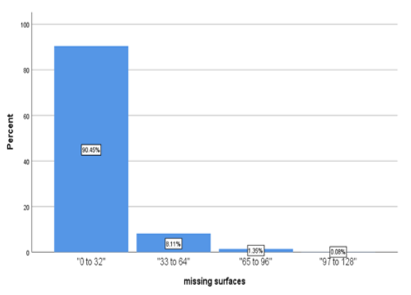Abstract
Dental caries remains a common disease worldwide. There is evidence indicating that many caries risk factors provide a gender bias, placing men at a higher caries risk. Generally, dental caries disproportionately affects the poor and racial or ethnic minorities worldwide, with men and women suffering more from the disease. This study aims to associate gender with missing tooth surfaces. Two thousand four hundred forty data of the study population with missing tooth surfaces were collected. They were recorded in the DMFS index. This retrospective study was done using the data collected from the educational software of Saveetha Dental College; from June 2019 to April 2020. The results were tabulated, and graphs were obtained. Descriptive statistics and the chi-square test was done. 52.34% of the male study population were more prone to missing tooth surfaces than the 47.66% female study population. 90.45% had 0 to 32 missing tooth surfaces that were more common, 8.11% had 33 to 64 missing tooth surfaces, 1.35% had 65 to 96 missing tooth surfaces, and 0.08% had 97 to 128 missing tooth surfaces. Males had more percentage of 0 to 32 missing tooth surfaces when compared to females( 48.46% vs 41.97%). This difference was found to be statistically significant (p=0.002). The study showed that the missing tooth surfaces were more common among males than females. Males have poor dietary habit and oral hygiene compared to females. Some of the contributing factors include diet, genes, oral environment, fluoride, caries, etc. More research is needed to define the role of all the contributors more clearly for us to understand the development of caries among both genders more thoroughly and to anticipate the disease process before it begins.
Full text article
Authors

This work is licensed under a Creative Commons Attribution-NonCommercial-NoDerivatives 4.0 International License.

